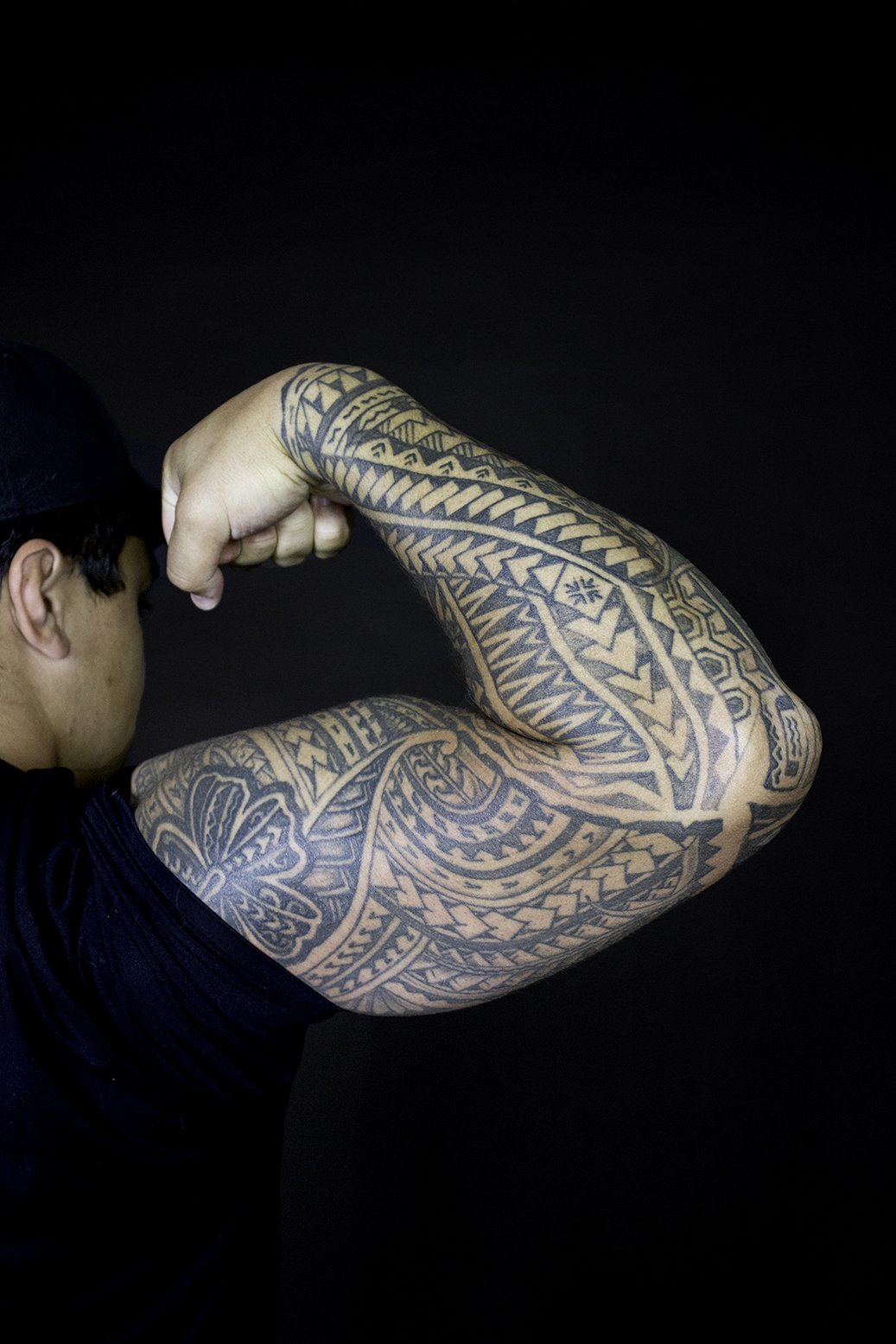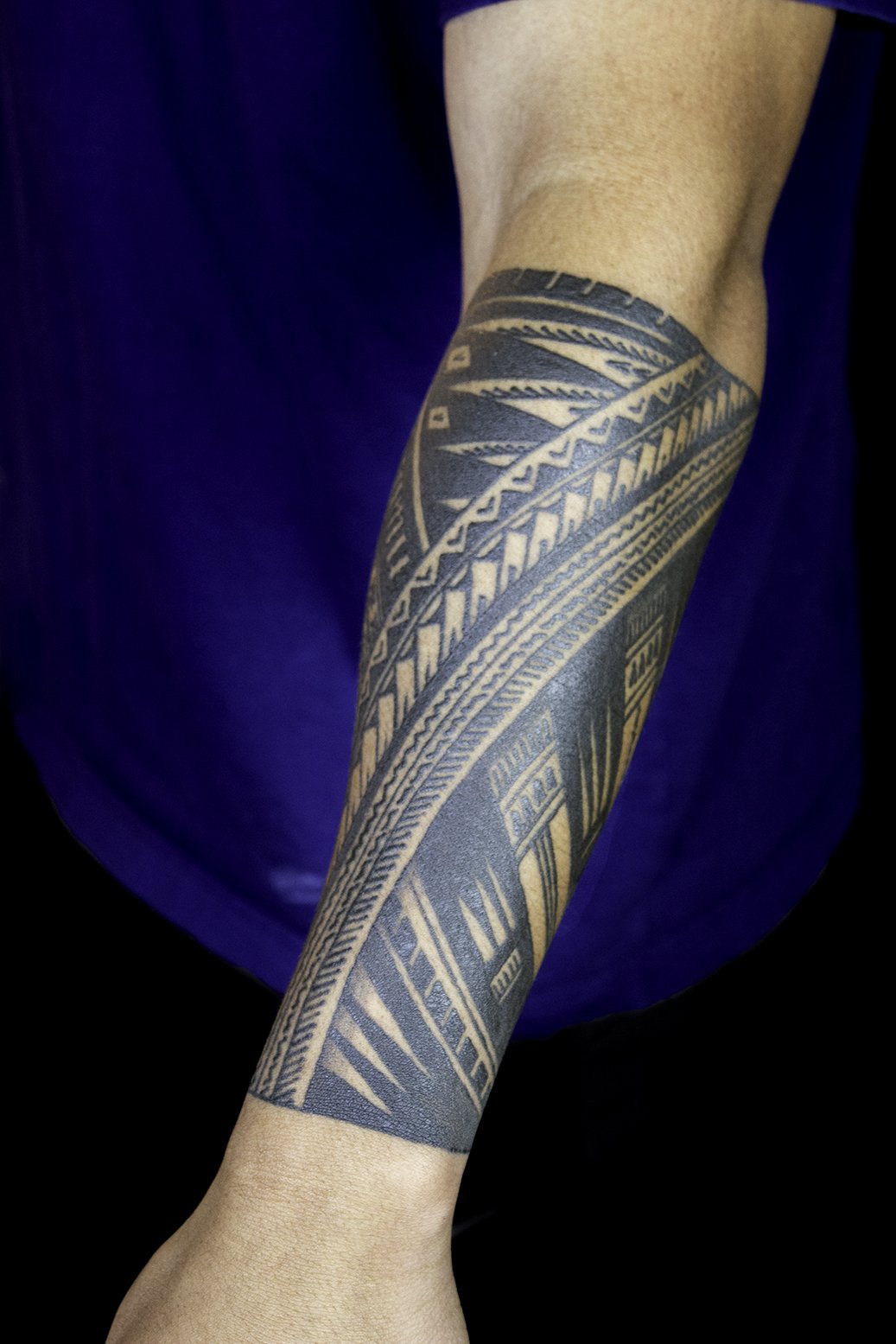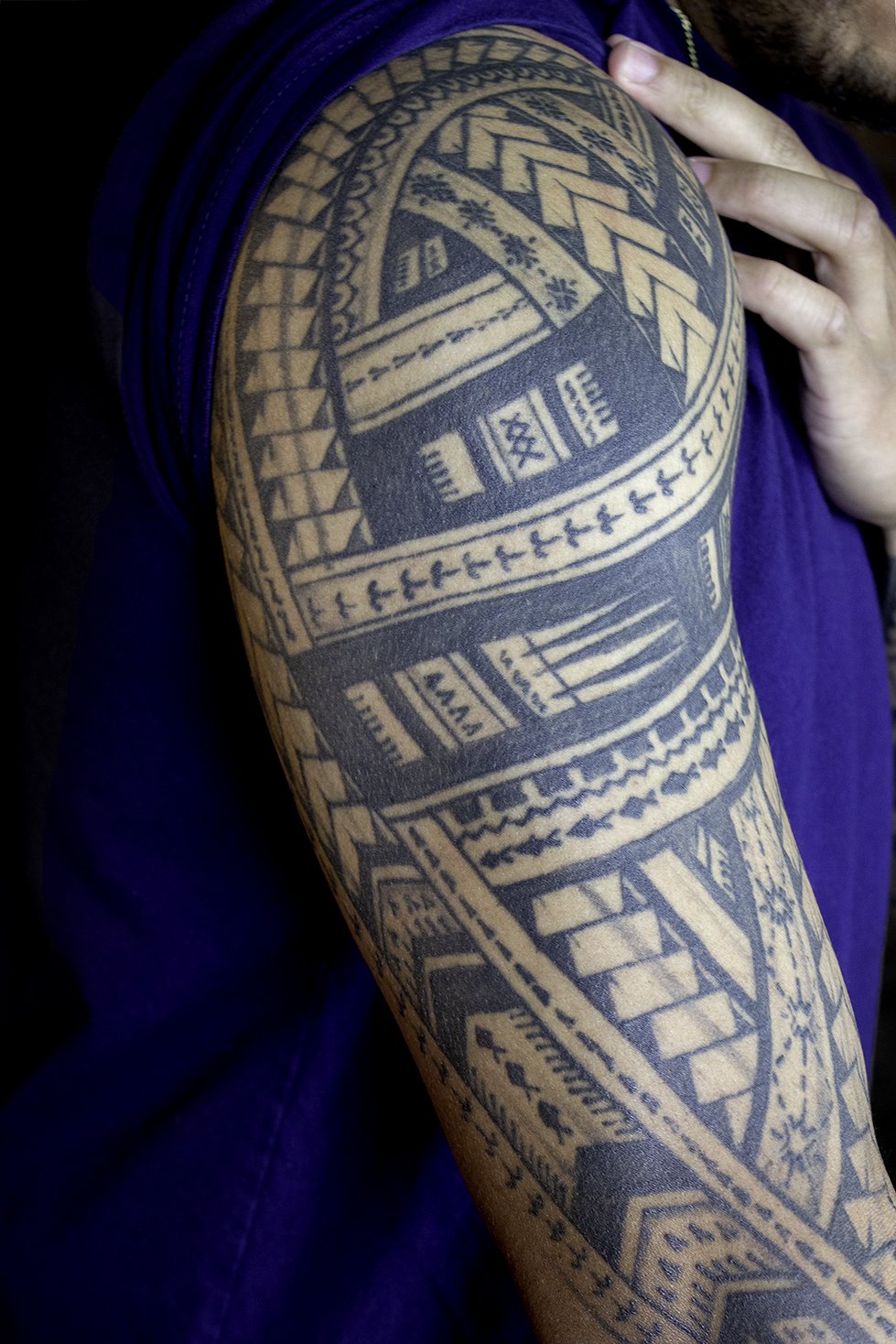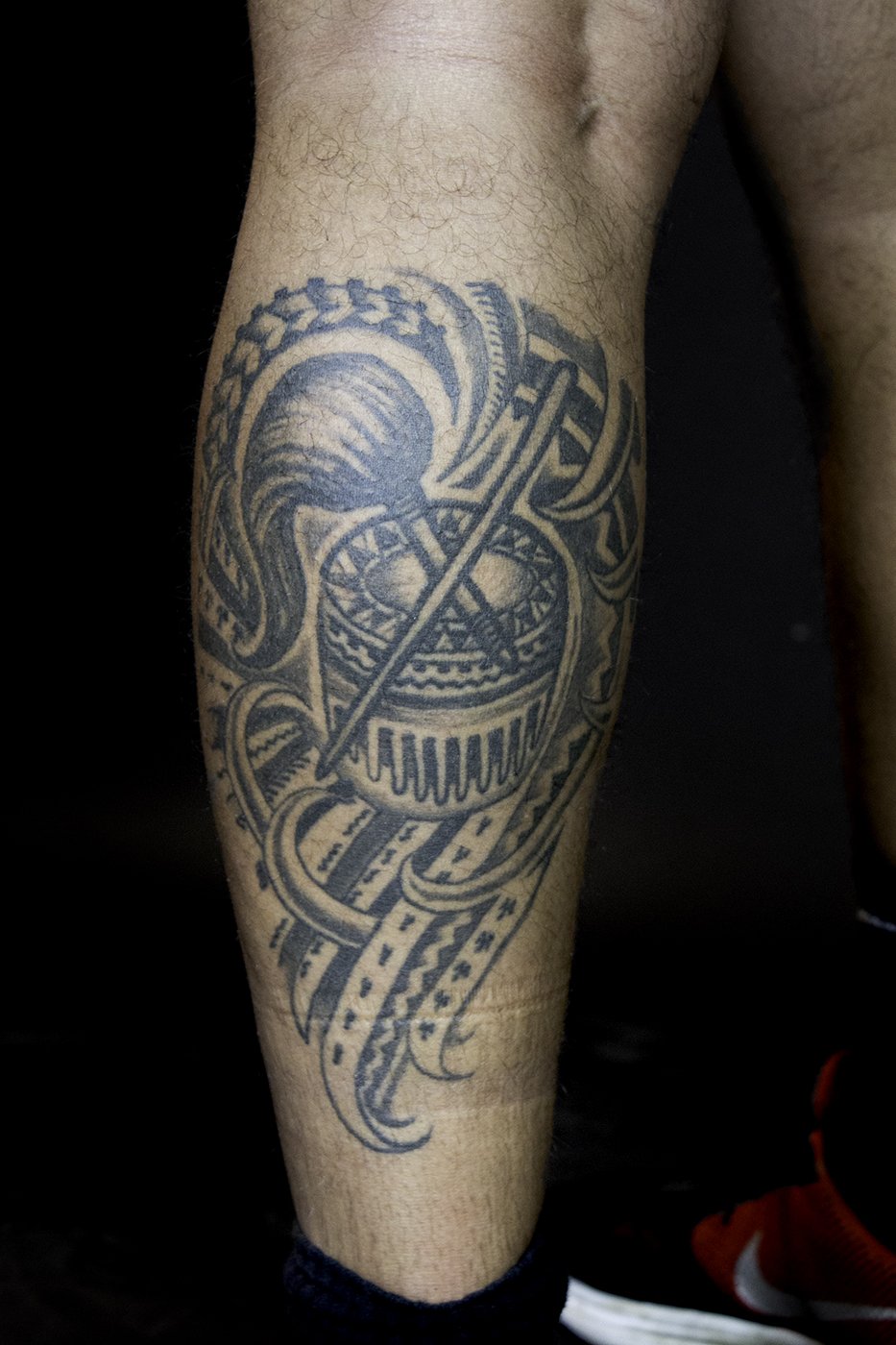Beyond Skin Deep
Story by Spencer Clifton | Photos by Kassandra Eller & Kamu Kamu | Design by Katie Jo Stewart
A sea of artwork lines the walls of the room and a strong odor of disinfectant and alcohol linger in the air. A harmonic “buzzing” hits your ear drums, and you can feel your excitement building. You are in a tattoo studio.
For many, the experience of getting a tattoo may mark a significant, exciting time in life. Individuals seek this artform for many different reasons, whether it is embodying freedom of expression or honoring significant life events and artwork. While tattoos have taken on their own culture and can capture an array of different aesthetics, for some this practice is rooted in family, culture and tradition.
“It’s all about us sharing that love that keeps you going in life,” says Kamu Kamu, tattoo artist and owner of Kamu Ink, located in Fife, WA .
Kamu has focused his craft on designing and tattooing Polynesian tribal tattoos as his way to spread and honor his culture in the Washington area, for over the last 10 years. While these tattoos are quite popular in modern times, this tribal tradition goes back generations.
Tattooing in Polynesia is a practice that dates back 2000 years, according to “Skin Stories,” a series of articles published by Public Broadcast System (PBS). This tradition is something that Nina Lemanu, Clinical Physiology senior and representative for the campus Polynesian club Poly Central, explains is “sacred” to her community.
“Tattoos [are] something that is very important in our culture,” Lemanu says. “[Traditionally] you would undergo a ritual almost. It is not something necessarily religious, but it is very sacred to our culture.”
Traditional Polynesian tattoos are quite different from the common modernization that you see today, according to Lemanu and Kamu. Kamu explains that there are two kinds of these traditional tattoos: the Samoa-HaÏti, which is given to men, and the Manu, which is given to women.
“It’s from the waist down to their knees,” says Kamu. “It covers the whole butt [and] thighs … that tribal that they get, it represents what they do for their families and their service,” says Kamu. “It is called the Tatau.”
He adds that Polynesians must go back to their island, and receive blessings from all living members of the family before they can go through the process of getting the Samoa-HaÏti or Malu. “You [are] becoming a new person after you get that done,” he says. “You are starting all over again, but you are becoming that main person that everyone in your family looks up to.”
These tattoos were often a rite of passage or coming of age ritual, according to Lemanu. They were traditionally given by tapping a whale bone or a boar tusk into the skin to apply the ink. This is a very painful process that can take up to weeks.
“It played an important part in your ascendance to a leadership role in your community,” says Lemanu.
Some traditions never die. While only practiced on the various Polynesian Islands, this traditional method is still done today, according to Kamu and Lemanu.
Kamu says because these tattoos are so sacred to Polynesian culture, he does not tattoo these pieces on anyone, but he still likes to “step out of the box” to create Polynesian designs that he “can share with the whole world.”
As traditional Polynesian tattoos have changed into a modern take on tribal designs, the meaning and stories behind the ink remain similar to their origin.
Traditionally, the tattoo artist would listen to the story of the individual and base the design off the individuals’ life, explains Lemanu. “You tell that story to the artist and they give the symbols to [bring it to] life how they think that should be, as you are telling your story,” she says.
Kamu adds, “All of the details in the tattoo mean something. It tells a story. So whatever the person is going through in life … [the artist] kind of builds the tribal that flows with it.”
This is not always practiced in modern tattooing, but Kamu likes to keep part of this tradition alive in his own way. “I take the time to sit down with my clients and listen to what they are going through,” he says.
One of his clients, Makani Mafua, Computer Science graduate student and American Samoan, has been adding onto his Polynesian tribal sleeve tattoo since he was 16.
Mafua says that he got his first tribal design with a hibiscus flower to honor some of the women in his family. “It was basically an ode to my mother and then also my grandmother on my dad’s side who was essentially like the head of the family at the time,” he says.
As Mafua adds to his sleeve, he continues to build his story into his skin, by adding a hook on the inside of his arm to represent becoming a man. “It was sort of my right of passage when I was leaving my parents' care … and I was becoming the provider for myself,” says Mafua.
Jonah Auva’a, American Samoan and Safety and Health Management senior, mentions that each island in Polynesia has varying symbols and designs that mean different things. It is common in modern tribal tattoos to blend these together.
“When you say the word Polynesian we are not just talking about Samoa,” says Kamu. “We are talking about Hawaii, Tahiti, Tonga, Fiji [and more]. So what I do is I pull out every little tribal [symbol] from every different island, and I know all the meanings from all the tribal designs and I put [them] together for that person.”
Mafua adds, “It varies from island to island … A lot of what you will see nowadays, especially if you are getting your tattoos on the mainland like I did, a lot of Polynesian artists are going to mix together a lot of the cultures because the designs make more sense, or they look more cohesive.”
Orlando Pescador Jr., former resident of Kauai, Hawaii and a Polynesian artist, designed his own tattoo by combining design elements and symbols from all of the different islands to tell his story of facing obstacles and of growing up. “I have this silhouette of man; an island motif of [a] man and it represents coming of age to be [a] man,” he says. “Everything represents strength that I have to face obstacles, and knowing I have this stability through the change.”
Lemanu adds that these symbols are unique looking and they help the tattoo “represent the community, power, status, respect, and honor.” She mentions many of these symbols take after nature, and resemble animals, trees and water.
“There is a lizard, which doesn’t look like a lizard,” she says. “You may think ‘oh, a lizard looks like this,’ [but] when we are tattooing it, it can be a little bit different. But it’s a guardian of evil, of conflict, of famine. You may see a lot of fish. That again is for abundance and prosperity.”
Pescador Jr. embraces nature symbols on his sleeve, incorporating a gecko, a bird, waves, flower petals and turtle shells into the overall design. “You see this [tattoo] that looks like a gecko, it represents luck. See that bird? That represents the freedom I have … The turtle shells I have right here represents [a] long life.”
The meanings of various symbols and patterns vary across the different Polynesian cultures, according to Lemanu. “One of my favorites is the waves or the flowy motion,” she says. “It can represent the loss of life, but also the gain of life. It can also mean danger. There are a lot of [double] meanings behind [them]. It is just what your symbols as a whole represent and what your story tells.”
While the symbols play a huge role in deciphering these intricate tattoos, the placement of the art also holds a significant role in the meaning behind the ink.
Auva’a mentions that when he went to get his tattoo, the artist explained to him that the right arm is for men, and the left arm is for women. “When I first went in, I intentionally wanted it on my left, but the artist was like ‘nah, the left side is for women,’ which was the first time I heard that,” he says.
Auva’a got his first tattoo on his right arm to honor his father’s side of the family incorporating his last name at the bottom. After learning that the left side was for women, he dedicated his left arm to his mom. He adds that besides honoring his family, he wanted a way to honor his culture since he never learned the language.
“There [are] a lot of people nowadays that grow up away from the islands, so they lose touch with the language,” says Auva’a. “I didn’t know the language, [which] is why I wanted to get tattoos to represent my culture.”
Pescador Jr. claims he got his sleeve on his left side to cover up his feminine side. “Back then it shows weakness,” he says. “That is why I covered it up.”
The various meanings behind placement, symbols and designs have evolved from traditional tribal tattoos, yet continue to hold significant value to people. These tattoos have now spread across continents, allowing other cultures to catch a glimpse at these modernized tribal pieces.
“I got people coming from Dubai that I have tattooed. I have people coming from Singapore [and] a lot of Canadians,” Kamu says. “I have tattooed people from far places. And it is incredible [they] go off to that side of the world and show off the work…”
Kamu likes to make sure that people know the meaning behind what they are getting, and to make sure they are getting something for good reason. He explains that many of his clients coming in want to represent their time in the military. “There are military folks that come in that want to represent themselves as warriors,” he says.
Pescador Jr. mentions that part of the evolution of these tattoos includes peoples’ attitudes towards getting them. “You see a lot more people that get it just to get it cause it looks cool,” he says. “It has become more of a trendy thing than a cultural thing or personal story.”
“I think one of the things that I struggle with over the last few years is that it feels like there are some people that think it is a fad and just a cool design to put on their body,” Mafua adds. “That’s not what it is. I have seen tattoos around and I’m like ‘I get it and I think it’s cool,’ I just don’t think it means the same thing to you that it means to me.”
Mafua explains that he is flattered that people of other cultures appreciate the artwork and culture enough to permanently mark it on their body. “While it is cool to observe it, and see it, and understand it and think it’s beautiful, it kind of does belong to the people who grew up that way,” he says. “There are parts of it that I think are missing for a lot of people.”
Pescador Jr. says that if you are going to get a tribal tattoo then you should “know what it means [because] it represents your story or personal struggle … that you have in life.”
Kamu adds he has no problem tattooing people of other cultures “as long as they respect it and they know what it means and it flows with their life.”
These unique, evolving works of art have left a permanent mark on more than people’s skin. “It’s all about us sharing that love that keeps you going in life,” says Kamu. “It is beautiful. That’s why I love what I do.”
“It is definitely a mark of pride to be worn by our culture,” says Lemanu. “It goes beyond skin deep.”







